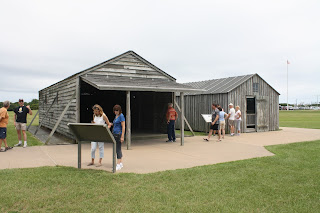One one afternoon, we drove around looking for lighthouses. I figured since we were near the ocean, and this was, after all the graveyard of the Atlantic, there had to be lighthouses, even if they were not still working or were automated like most of the rest of them around the country. We were successful in finding several.
The Bodie lighthouse(right), a horizontally striped one, was located south of Nag's Head. We stopped here for a short time, and walked around the grounds. And even though it doesn't look like it in the picture, just to the right of the scene, there was a severe storm churning out at sea and the winds and rain were making their way toward us. The rangers closed the lighthouse because the storm appeared to be gaining strength as it came up north, toward the coast. As it turned out, the whole thing changed course and went back out to sea. Pranked us.
 The other one what we saw, the Currituck Beach Lighthouse (below-right) was pretty cool. There was a whole village there that has been preserved over the years. The Currituck area was a private home for one of the very wealthy people of the time. The whole island area was his private retreat. At 162' feet tall, the lighthouse's First Order Fresnel light, (the
largest size available for American lighthouses), can be seen for 18
nautical miles as the light rotates in 20 second increments.
The other one what we saw, the Currituck Beach Lighthouse (below-right) was pretty cool. There was a whole village there that has been preserved over the years. The Currituck area was a private home for one of the very wealthy people of the time. The whole island area was his private retreat. At 162' feet tall, the lighthouse's First Order Fresnel light, (the
largest size available for American lighthouses), can be seen for 18
nautical miles as the light rotates in 20 second increments.
This lighthouse stands out for its distinctive red exterior. This design
was intentional, to set the Currituck Lighthouse apart from its Outer
Banks neighbors. After completion, the lighthouse was left unpainted,
allowing visitors to marvel at the sheer number of bricks involved in
its construction.
The mansion (shown below) was built by Edward Collings Knight Jr. for his wife Marie Louise. They shared a passion for hunting waterfowl. But in those days, Mrs. Knight wasn’t welcomed in the all-male hunt clubs. Mr. Knight’s answer was to build a 21,000-square-foot “mansion by the sea” just for his bride. With its bold yellow paint, copper roof and mahogany doors, the Whalehead invites you to explore a fascinating period in Outer Banks history. Nearly every inch of the home has been carefully restored to the way it looked when Edward Collins Knight Jr. and his wife, Marie Louise, first opened the doors as a lavish hunting retreat in 1925.
We did not tour the mansion, but one thing I was told was that the copper roof was used to draw heat and help cool the place. It also would allow rain water to flow unimpeded into collecting tanks as that was their source of water for some cooling, household drinking and other requirements. Evidently, Knight was very much into conservation and the ecology. I was told that the center chimney was not really a means of letting smoke out of the building. Rather, it served as a means of letting cool fresh air into the structure as it was drawn in by the flow created through the lower story windows. There was no air conditioning back then, and the mansions still is not retrofitted for A/C.
Whether it was marveling at the amount of work required to build the Currituck lighthouse, one brick at a time, and my losing count after about ten rounds of bricklaying, or trying to figure out the aerodynamic flow of air and heat through the Knight's mansion, I came away convinced that there were some pretty amazing and industrious people in this country in the old days.With crude tools and methods, lots of sweat and muscle, and NO computers to fall back on, they built this country and made it a truly GREAT place.
Whoever wrote the bad review of the OBX must not have made their way over here.
Men, great and small, must act like the lighthouse; they must shine day and night for the goodness of everyone. They must take their light, no matter how bright, and reach out into the darkness in search of those who need help.
Hooah











